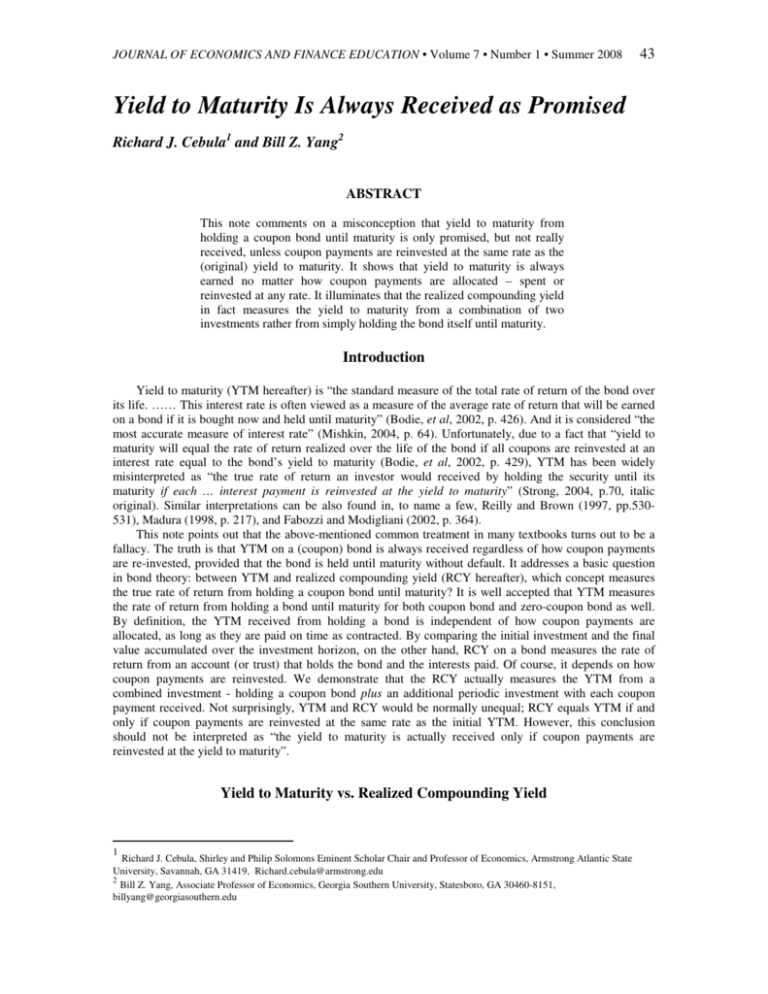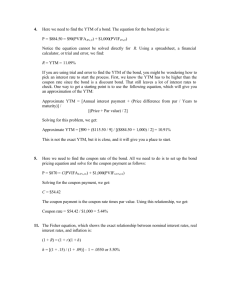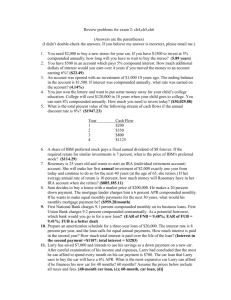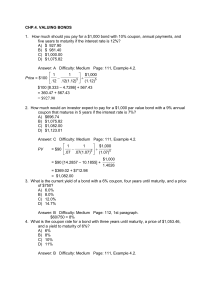
JOURNAL OF ECONOMICS AND FINANCE EDUCATION • Volume 7 • Number 1 • Summer 2008
43
Yield to Maturity Is Always Received as Promised
Richard J. Cebula1 and Bill Z. Yang2
ABSTRACT
This note comments on a misconception that yield to maturity from
holding a coupon bond until maturity is only promised, but not really
received, unless coupon payments are reinvested at the same rate as the
(original) yield to maturity. It shows that yield to maturity is always
earned no matter how coupon payments are allocated – spent or
reinvested at any rate. It illuminates that the realized compounding yield
in fact measures the yield to maturity from a combination of two
investments rather from simply holding the bond itself until maturity.
Introduction
Yield to maturity (YTM hereafter) is “the standard measure of the total rate of return of the bond over
its life. …… This interest rate is often viewed as a measure of the average rate of return that will be earned
on a bond if it is bought now and held until maturity” (Bodie, et al, 2002, p. 426). And it is considered “the
most accurate measure of interest rate” (Mishkin, 2004, p. 64). Unfortunately, due to a fact that “yield to
maturity will equal the rate of return realized over the life of the bond if all coupons are reinvested at an
interest rate equal to the bond’s yield to maturity (Bodie, et al, 2002, p. 429), YTM has been widely
misinterpreted as “the true rate of return an investor would received by holding the security until its
maturity if each … interest payment is reinvested at the yield to maturity” (Strong, 2004, p.70, italic
original). Similar interpretations can be also found in, to name a few, Reilly and Brown (1997, pp.530531), Madura (1998, p. 217), and Fabozzi and Modigliani (2002, p. 364).
This note points out that the above-mentioned common treatment in many textbooks turns out to be a
fallacy. The truth is that YTM on a (coupon) bond is always received regardless of how coupon payments
are re-invested, provided that the bond is held until maturity without default. It addresses a basic question
in bond theory: between YTM and realized compounding yield (RCY hereafter), which concept measures
the true rate of return from holding a coupon bond until maturity? It is well accepted that YTM measures
the rate of return from holding a bond until maturity for both coupon bond and zero-coupon bond as well.
By definition, the YTM received from holding a bond is independent of how coupon payments are
allocated, as long as they are paid on time as contracted. By comparing the initial investment and the final
value accumulated over the investment horizon, on the other hand, RCY on a bond measures the rate of
return from an account (or trust) that holds the bond and the interests paid. Of course, it depends on how
coupon payments are reinvested. We demonstrate that the RCY actually measures the YTM from a
combined investment - holding a coupon bond plus an additional periodic investment with each coupon
payment received. Not surprisingly, YTM and RCY would be normally unequal; RCY equals YTM if and
only if coupon payments are reinvested at the same rate as the initial YTM. However, this conclusion
should not be interpreted as “the yield to maturity is actually received only if coupon payments are
reinvested at the yield to maturity”.
Yield to Maturity vs. Realized Compounding Yield
1
Richard J. Cebula, Shirley and Philip Solomons Eminent Scholar Chair and Professor of Economics, Armstrong Atlantic State
University, Savannah, GA 31419, Richard.cebula@armstrong.edu
2
Bill Z. Yang, Associate Professor of Economics, Georgia Southern University, Statesboro, GA 30460-8151,
billyang@georgiasouthern.edu
JOURNAL OF ECONOMICS AND FINANCE EDUCATION • Volume 7 • Number 1 • Summer 2008
44
Yield to maturity (YTM) of a coupon bond is defined as the solution for variable y from the following
equation
N
C
∑ (1 + y)
P =
t =1
t
+
F ,
(1 + y) N
(1)
where P is the purchase price of the bond, C is the periodical coupon payment, F is the face value and N is
the term to maturity. The YTM measures the theoretic annual rate of return from this investment, provided
the investor holds it until maturity and receives C per period as well as F at maturity as contracted. That is,
the YTM is completely determined by the cash flows paid and received by the investor over the investment
horizon. By definition, nothing has been assumed regarding how coupon payments are allocated –
reinvested at a specific rate or simply spent when received. The only implicit assumption on coupon
payments (and the par value) is that they are received on time as promised, i.e., no default.
Why do so many authors emphasize that the YTM is actually received only if the coupon payments are
reinvested at the same rate as YTM? It stems from misinterpreting another measure of (annual) rate of
return – realized compound yield (RCY), which is formally defined as follows:
1
N
RCY = - 1 + VN
P
(2)
where P = funds initially invested (or initial purchase price), VN = current value accumulated from the
investment at the end of period N. Note that RCY is determined exclusively by the initial investment and
the final value accumulated from the investment without specifying the cash (in- or out-) flows on the
investment during the investment horizon. Solving for P, we can rewrite (2) as
P =
VN
.
(1 + RCY ) N
(3)
It implies immediately from equation (3) that if an investor holds to maturity a zero-coupon bond that pays
cash in-flows only at maturity, obviously, RCY = YTM.
Proposition 1. For a zero-coupon bond, RCY = YTM.
If an investor holds a coupon bond that pays cash in-flows periodically until maturity, the value
accumulated from all cash in-flows at the end of investment horizon, VN, depends on whether coupon
payments are spent or reinvested, and at what rate if reinvested.3 Hence, RCY may or may not equal the
YTM as calculated at the time of purchase.
To illuminate how the statement is incorrectly reached that YTM is actually received only if coupon
payments are reinvested at YTM, we first show how RCY is linked with YTM from holding a coupon
bond. For the purpose of exposition, we examine three different investments:
1)
2)
3)
buying and holding a coupon bond until maturity;
(re)investing every coupon payment whenever received;
holding a portfolio that combines these two investments.
-P
C
C
C
C
0
1
2
3
4
C+F
Coupon bond
3
…
N
t
When a coupon payment is received and simply spent rather than reinvested, it can be interpreted as being reinvested at a rate of 100%.
JOURNAL OF ECONOMICS AND FINANCE EDUCATION • Volume 7 • Number 1 • Summer 2008
N −1
Reinvesting
Coupon payments
-C
-C
-C
-C
1
2
3
4
45
∑ (1 + y ) C
t
r
t =1
0
…
N
N −1
∑ (1 + y ) C + F
-P
Combination of
two investments
t
t
r
t =0
0
1
2
3
4
…
N
t
Figure 1: Time lines of three different investments
Figure 1 above describes the time lines with cash flows of each of the three investments. Formally, let
YTM1 denote the YTM on holding the coupon bond until maturity. By definition, YTM1 is determined in
the following equation
N
P =
C
∑ (1 + YTM )
t =1
t
+
1
F
.
(1 + YTM 1 ) N
(1')
Clearly, YTM1 is entirely determined by parameters P, C, F and N, and independent of how C’s are
allocated – simply spent or reinvested at any rate.
To invest an amount equal to the coupon payment periodically when they are received at a rate of yr is
another investment. The YTM from such a separate investment, denoted as YTM2, is determined by its
cash out-flows and in-flows as follows
N −1
0 =
∑
t =1
−C
1
+
t
(1 + YTM 2 )
(1 + YTM 2 ) N
N −1
∑ C (1 + y )
r
t
.
(4)
t =1
Rewriting (4) as
N −1
∑ C (1 + YTM
2
N −1
∑ C (1 + y )
)t =
r
t =1
t
,
(4’)
t =1
we can obtain that that YTM2 = yr .4
Holding the coupon bond until maturity and reinvesting all coupon payments at a rate of yr when
received, as a matter of fact, combines the above two investments. Let YTM12 denote the YTM on this
combined investment. From the time lines in Figure 1, it implies that it is determined in the following
equation (5):
N −1
∑ (1 + y ) C
t
r
P =
4
+F
t =0
(1 + YTM 12 ) N
.
(5)
For the uniqueness of solution to such an equation, see, for example, Theorem 6.2(d) on Descartes’ Rule of sign, in Henrici (1974,
p. 422).
JOURNAL OF ECONOMICS AND FINANCE EDUCATION • Volume 7 • Number 1 • Summer 2008
46
Note that this combined investment is like a zero-coupon bond that does not generates any cash in-flows
until maturity. Explicitly solving for YTM12 from equation (5), we obtain
1
YTM12
=
-1 +
N −1
N
t
∑ (1 + yr ) C + F
t =0
.
P
(6)
Comparing equation (6) with equation (2), we have YTM12 = RCY with all coupon payments being
reinvested at a rate of yr. Hence, RCY is essentially the YTM on the combined investment that holds the
coupon bond and reinvests its coupon payments when received.
Then, how is RCY (= YTM12) related to YTM1? If yr = YTM1, then YTM1 also solves equation (5),
since YTM1 solves equation (1). Note from (6) that RCY is an increasing function of yr. The uniqueness of
solution of equation (1) and the monotonicity of RCY in yr imply that RCY = YTM1 if and only if yr =
YTM1. This is quite intuitive. By structure, RCY (= YTM12) measures the annual rate of return from the
combination of the first two investments. That is, RCY is a weighted average of YTM1 and YTM2.
Therefore, when YTM1 = YTM2, their average, RCY, must be equal to both of them. We summarize the
outcomes from above analysis in the following:
Proposition 2. For an investor who holds a coupon bond until maturity,
(i)
YTM1 as defined in equation (1) measures the annual rate of return actually received by the bond
investor, regardless of how coupon payments are re-invested, ie., independent of yr.
(ii)
RCY = YTM12 measures the yield to maturity from a combined investment of holding the bond until
maturity plus reinvesting coupon payments at a rate of yr.
(iii)
RCY ≥ (<) YTM1 if and only if yr ≥ (<) YTM1.
The Root of the Fallacy
The results summarized in Proposition 2 are quite clear and intuitive. However, result (i) has been
ignored, though it can be easily seen from the definition of YTM per se; outcome (ii) has been probably
overlooked and it is not recognized that RCY is in fact the YTM of a portfolio/trust; and the worst,
conclusion (iii) has been misinterpreted as “YTM1 (from holding the coupon bond until maturity) is
actually received only if RCY = YTM1.” This misinterpretation simply tells students and readers that if a
coupon bond is purchased at a price of P, the YTM as calculated from Equation (1) is only a promise to the
bond holder at the time of purchase, but may not be really received, unless P(1 + YTM)N can be
accumulated at the end of period N by reinvesting all coupon payments at the same rate as the initial YTM.
Implicitly, the concept behind such a misinterpretation is that the RCY, rather than the YTM, should be the
measure of rate of return on holding a bond per se to maturity.
Do bond investors have to reinvest all coupon payments at the same rate as YTM to earn such an
annual rate of return by holding it until maturity? Let’s look at a simple example. Two bond investors, A
and B, both have bought the same coupon bond at the face value and hold it until maturity. When receiving
the coupon payment, investor A always deposits the same amount of money as the coupon payments in a
savings account that happens to offer the same interest rate as the coupon rate, whereas investor B has to
rely on the coupon payments as a source of income to pay bills. At the time when the bond is mature,
investor A has accumulated much more wealth due to reinvesting coupon payments and the power of
compounding, but investor B only has the face value redeemed. So, what annual rate of return does each of
two investors earn from holding the bond? Should we measure it with YTM1 or RCY?
In this example, the two investors have earned the same YTM1 but different RCY. For investor A,
RCY = YTM1, while for investor B, RCY = 0. Hence, if RCY is used to measure the annual rate of return
actually earned from holding the bond, then investor A has earned an annual rate of return that is equal to
JOURNAL OF ECONOMICS AND FINANCE EDUCATION • Volume 7 • Number 1 • Summer 2008
47
YTM1, and investor B has a zero rate of return! If one tells invest B that he has earned nothing from
holding the bond, he would either laugh or get very confused. By investing the amount of face value (F),
investor B has received coupon payment (C) year in year out until maturity. Obviously, every year he has
earned a rate of return of C/F (= YTM1 in this example) while holding the bond. Indeed, investor A would
have accumulated much more wealth than investor B over such an investment horizon. It is, however, not
because the reinvestment makes A’s coupon bond yield higher than B’s bond does, but because the former
has additional funds periodically invested.
To summarize, RCY does not measure the rate of return earned from holding the bond per se. Rather,
it measures the rate of return earned from two investments – holding the bond plus saving a constant
amount every period while holding the bond. When claiming YTM1 is actually earned only if coupon
payments are reinvested at YTM1, one might have confused between YTM12 (= RCY) and YTM1; in fact,
the former measures the rate of return from a portfolio or trust that holds the bond as well as its coupon
payments, while the latter measures the rate of return from holding the bond per se no matter how coupon
payments are reinvested. Confusion between the two investments may be the root of the fallacy.
Yield to Maturity or Realized Compounding Yield: A practical discussion
As analyzed above, we articulate that YTM and RCY are two different and important methods to
measure the rate of return from investments. Basically, YTM measures the rate of return from holding a
bond no matter how coupon payments are disposed, while RCY measures the rate of return from holding
the bond plus re-investing coupon payments when received.
Hence, in practice investors with different purposes for investment may want to use different measure
when making an investment decision. Specifically, if one decides to spend the coupon payments when
received, then YTM should be used to measure the rate of return from holding a coupon bond. If instead,
one plans to save every penny for the future and likes to know his rate of return from the investment
portfolio, then he should consider RCY as the measure of the rate of return from the (combined)
investments since they include re-investment as well. Moreover, if one is mostly concerned about reinvestment risk, then zero-coupon bond is a better vehicle (than coupon bond) in investment since RCY =
YTM for zero-coupon bond and there is no re-investment risk at all.
References
Bodie, Zvi, Alex Kane, and Alan J. Marcus, 2002. Investments, 5th edition, McGraw-Hill Irwin
Fabozzi, Frank, J. and Franco Modigliani, 2002. Capital markets – Institutions and Instruments, 3rd edition,
Prentice Hall
Henrici, Peter, 1974. Applied and computational complex analysis, vol. 1, John Wiley & Sons, Inc.
Madura, Jeff, 1998. Financial markets and institutions, 4th edition, South Western College Publishing
Mishkin, Frederic S., 2004. The economics of money, banking and financial markets, 7th edition, Pearson
Addison Wesley
Reilly, Frank K., and Keith C Brown, 1997. Investment analysis and portfolio management, 5th edition,
Dryden
Strong, Robert A., 2004. Practical investment management, 3rd edition, Thomas Southwestern










